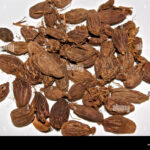A Spice with a Story: Black Pepper’s Global Influence
Black pepper, an unassuming pantry staple, holds a captivating history intertwined with global trade, culinary innovation, and ancient medicinal practices. Originating on the Malabar Coast of India, this “king of spices” fueled ancient trade routes, symbolizing wealth and influencing culinary traditions across continents. This comprehensive guide delves into the multifaceted world of black pepper, exploring its journey from vine to table and uncovering its hidden depths. From its impact on global economies to its potential health benefits, black pepper’s story is as complex and intriguing as its flavor profile.
From Berry to Peppercorn: The Art of Black Pepper Production
The transformation of peppercorns from vibrant green berries on the Piper nigrum vine to the dried, wrinkled spice we know and love is a meticulous process. Cultivated in tropical regions, the unripe berries are harvested and then sun-dried, a process that concentrates their pungent flavor and creates their signature dark hue. Variations in processing techniques yield green, white, and red peppercorns, each with distinct flavor nuances. Factors such as sunlight exposure, soil composition, and harvesting time influence the final peppercorn’s aromatic complexity and pungency. For instance, Tellicherry peppercorns, known for their robust flavor, are harvested at full ripeness, resulting in a bolder and more developed taste.
Piperine: The Secret Behind Black Pepper’s Power
Piperine, the alkaloid responsible for black pepper’s characteristic bite, is more than just a flavor compound; it’s a subject of scientific inquiry. Research suggests piperine possesses antioxidant and anti-inflammatory properties, potentially playing a role in protecting cells from damage and reducing inflammation. Furthermore, piperine is believed to enhance the bioavailability of certain nutrients, like curcumin from turmeric, making it a valuable addition to a balanced diet. Studies also explore piperine’s potential impact on brain health, blood sugar control, and even cholesterol levels. While further research is needed to confirm these benefits in humans, the preliminary findings highlight the potential health-promoting properties of this remarkable compound.
Mastering Black Pepper: A Guide to Selection, Use, and Culinary Exploration
To unlock the true potential of black pepper, freshly ground peppercorns are paramount. The volatile aromatic compounds that give black pepper its distinctive character dissipate quickly after grinding. Investing in a high-quality pepper grinder and whole peppercorns allows you to experience the full spectrum of its flavor and aroma. Exploring different peppercorn varieties, such as Tellicherry, Lampong, or Sarawak, unveils a world of flavor nuances, from citrusy and floral notes to earthy and robust profiles. Experimenting with these varieties can elevate your culinary creations, adding depth and complexity to savory dishes, desserts, and even beverages. Consider a sprinkle of coarsely ground Tellicherry peppercorns over a rich chocolate mousse or a pinch of Lampong pepper in a refreshing fruit salad for an unexpected flavor dimension.
Black Pepper’s Global Impact: Trade, Sustainability, and Future Considerations
Black pepper’s influence extends far beyond the kitchen; it is a significant global commodity with Vietnam currently leading the world in production. This trade plays a crucial role in the economies of producing nations, highlighting the importance of ethical sourcing and sustainable farming practices. Promoting fair trade principles, supporting local farmers, and ensuring environmental responsibility are essential for the long-term viability of the black pepper industry. Addressing issues like adulteration and ensuring quality control are crucial for maintaining consumer trust and preserving the integrity of this valuable spice. By embracing sustainable practices and supporting ethical production, we can ensure the future of black pepper for generations to come.
Scientific Scrutiny: Evaluating Black Pepper’s Health Claims
While preliminary research suggests intriguing potential health benefits associated with piperine and black pepper, it’s crucial to approach these claims with informed skepticism. Rigorous scientific investigation, including large-scale randomized controlled trials (RCTs) published in reputable peer-reviewed journals, is necessary to substantiate these early findings. Exploring the interactions of piperine with other spices and foods is another important area of research, as synergystic effects could enhance or alter its purported health benefits. Consumers are encouraged to rely on credible, evidence-based information from reputable sources when evaluating health claims related to black pepper consumption.
Cultivating Excellence: The Science and Art of Peppercorn Farming
Cultivating black pepper successfully requires a deep understanding of the plant’s needs and the specific environmental conditions it thrives in. From selecting the appropriate peppercorn variety to optimizing soil composition and implementing effective pest management strategies, every step in the process impacts the final product. Sustainable farming techniques, such as intercropping and organic farming methods, can minimize environmental impact and enhance the quality of the peppercorns. Post-harvest processing techniques, including careful drying and storage methods, are equally critical for preserving the peppercorns’ aroma, flavor, and overall quality. Innovation in farming practices, such as precision agriculture and the development of disease-resistant varieties, holds the key to a sustainable and thriving future for black pepper cultivation.
Black Pepper in Southeast Asian Cuisine: A Cornerstone of Flavor
Black pepper transcends its role as a mere seasoning in Southeast Asian culinary traditions; it is an integral element that defines and elevates the region’s diverse flavors. From the aromatic broths of Vietnamese pho to the complex curries of Thailand and the fiery sambals of Indonesia, black pepper adds depth, complexity, and a touch of heat to a vast array of dishes. The specific type of peppercorn used, whether it’s the bold Tellicherry or the more delicate Lampong, can significantly influence the final flavor profile. Understanding these nuances allows cooks to harness the full potential of black pepper, creating culinary masterpieces that reflect the rich and diverse culinary heritage of Southeast Asia. The use of freshly ground black pepper in these cuisines contrasts with the pre-ground pepper often used in Western cooking, showcasing a deep appreciation for the spice’s fresh, vibrant flavor.
- Jesus Bible: Discover Jesus’s Story Throughout Scripture - April 27, 2025
- Don Luis: Unraveling the 16th-Century Virginia Mystery - April 27, 2025
- Captain J’s Kauai Tours: Unforgettable Na Pali Coast Adventures - April 27, 2025
















